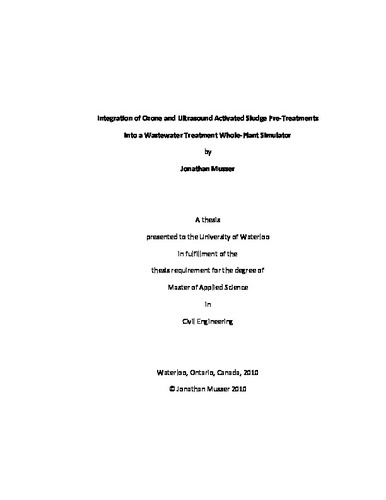| dc.description.abstract | Modern wastewater treatment provides great benefit to society by reducing the transmission of disease. In recent years computer simulation of whole plants has allowed for improved design and more economical consideration of alternatives. One new alternative for wastewater treatment is the pre-treatment of sludges, although this technology has not yet been adapted for computer simulation. This thesis describes research which was conducted to describe pre-treatments in terms appropriate for whole-plant computer models.
Pre-treatment shows promise in terms of reducing sludge, a waste product the disposal of which can be costly depending on the applicable regulations. At the same time pre-treatment can improve the generation of biogas, which is readily converted to heat and/or electricity and can help to offset treatment energy requirements. Pre-treatments can be broadly categorized as physical, chemical, or thermal. For this study, ultrasound was selected as a model physical pre-treatment and ozone as a model chemical pre-treatment. The range of doses to be tested was obtained by reviewing earlier literature.
Waste activated sludge was obtained from pilot reactors treating screened municipal wastewater. This sludge was subjected to a range of doses in batch reactors. Conventional laboratory analyses were used to determine the effects of pre-treatment on such parameters as chemical oxidant demand, solids, and various nitrogen fractions. As well, respirometry was utilized to estimate the biologically active and bioavailable fractions. A novel technique for analysis of respirometric data was developed, which consisted of fitting synthetic oxygen uptake rate curves to the measured data.
Both ultrasound and ozone were observed to decrease the amount of active biomass present while increasing the amount of biodegradable material. The conversions between these fractions were modeled using simple functions of pre-treatment dose. For ultrasound, a conversion which exponentially decayed with respect to increasing ultrasound dose was used to relate these fractions. For ozone, the conversion from active biomass to slowly degradable material occurred more slowly than the conversion to rapidly degradable material; as such two conversions were modeled, each exponentially decaying with respect to dose but with different dose constants.
The observed conversions were added to a whole-plant model and the implications of the models were considered for one simple wastewater treatment plant. Both pre-treatments showed a decrease in total sludge production and an increase in biogas production, as predicted by earlier research. Published full-scale results were not reported with sufficient detail to be replicated, and so a quantitative comparison was not possible. | en |

